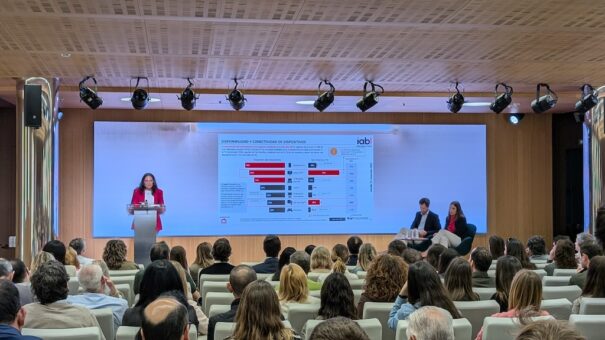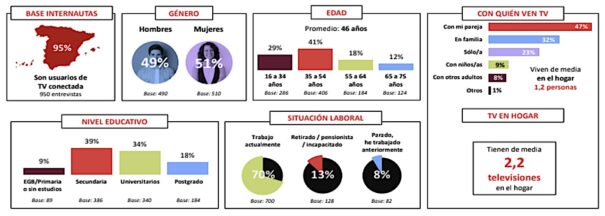Casi 34 millones de personas consumen en España contenido audiovisual a través de Internet
El 95% de los internautas entre 16 y 75 años, lo que equivale a casi 34 millones de personas, utiliza servicios de contenido audiovisual a través de Internet para televisión. Así se desprende del Estudio de Televisión Conectada 2025, que ha presentado IAB Spain, la asociación de publicidad, marketing y comunicación digital en España.
Según el estudio, patrocinado por Publiespaña y elaborado en colaboración con Elogia, la penetración de la tv conectada se mantiene estable respecto a 2024, con una adopción similar por sexo (51% mujeres y 49% hombres) y destacada entre las personas de 16 a 54 años. Además, la mayoría de los usuarios ven televisión en compañía (77%), especialmente con su pareja (47%) o en familia (32%). Las series (84%) y el cine (77%) siguen siendo los contenidos más consumidos, seguidos de los informativos (41%) y el deporte (36%).
El promedio diario de consumo de tv conectada alcanza los 132 minutos, siendo los mayores de 65 años los que dedican más tiempo, con una media de 161 minutos al día. Los picos de mayor consumo se concentran durante la cena (56%) y antes de acostarse (60%). En cuanto a las preferencias de contenido, los usuarios optan principalmente por contenidos bajo demanda (82%), aunque 1 de cada 2 también elige contenidos lineales emitidos en tiempo real.
Las series (84%) y el cine (77%) son los contenidos más consumidos, seguidos de los informativos, los deportes y las entrevistas/ entretenimiento. La noche sigue siendo el principal momento para consumir contenido de TV y audiovisual: el 60% lo hace antes de acostarse y el 56% durante la cena. El prime time se sitúa entre las 21h y las 23h de la noche (79%), aunque se aprecia también un pequeño pico de consumo entre las 15h y las 17h (27%).
Dispositivos y hábitos de conexión
El 76% de los usuarios accede a la tv conectada a través de un Smart TV, consolidándose como la opción principal. Sin embargo, una proporción significativa de usuarios, a pesar de contar con un Smart TV, opta por otras alternativas para consumir CTV. Entre estas opciones destacan los decodificadores —como Google Chromecast, Apple TV, Fire TV de Amazon, Agile TV, o los decodificadores de Movistar Plus+—, así como smartphones y tablets.
Además, el estudio también revela que casi la mitad de los usuarios (49%) utilizan otro dispositivo mientras consumen tv conectada, destacando el uso del smartphone (94%), sobre todo para navegar por redes sociales (77%) e Internet (61%). En este punto son mayoría las mujeres, representando el 57% de las personas que emplean otros dispositivos a la vez que consumen TV Conectada, así como los jóvenes (62%).
La publicidad en tv conectada tiene mayor aceptación con respecto al año pasado. De hecho, el 76% de los usuarios estaría dispuesto a abaratar el coste del servicio a cambio de publicidad. Por otro lado, los momentos preferidos para ubicar la publicidad en plataformas de TV Conectada es antes del programa (45%), después del programa (30%) y al acceder a la plataforma (22%). En cuanto al formato publicitario más recordado por los usuarios de tv conectada, destaca el display en menú (64%) siendo también su favorito (55%). Le siguen el Formato L y el Formato Ad pause. En cuanto a la perspectiva de los profesionales del marketing digital, más del 80% asegura estar invirtiendo en tv conectada o tiene intención de hacerlo durante este año. Las principales motivaciones incluyen adaptarse a los nuevos hábitos de consumo (51%) y alcanzar audiencias que ya no recurren a medios tradicionales (49%). Además, el 78% destaca las ventajas competitivas de la TV Conectada, como la cobertura incremental frente a la TV convencional (48%), el uso estratégico de datos (42%) y el incremento de la cobertura de la campaña (41%).
Para Esther Balbací, directora de Marketing Operativo de Publiespaña, «los resultados del nuevo estudio de Televisión Conectada de la IAB confirman que, la televisión conectada sigue experimentando su tendencia creciente y su consolidación como un canal clave dentro del ecosistema audiovisual. Esta evolución no solo responde a los cambios en los hábitos de consumo de los espectadores, que demandan cada vez más contenidos y experiencias personalizadas, sino que también representa una gran oportunidad para los anunciantes para innovar y potenciar la inversión publicitaria. La televisión conectada permite combinar el alcance y la fuerza del entorno televisivo con la precisión y segmentación propia del mundo digital, generando un entorno publicitario de alto valor, más eficiente y medible. En Publiespaña apostamos firmemente por este entorno, que aporta valor tanto a las marcas como a los espectadores y, seguiremos apoyando todas las acciones que puedan impulsar a la televisión conectada, como este nuevo estudio de IAB Spain, que se ha convertido en una herramienta fundamental para todo nuestro mercado, ya que aborda todos los factores que preocupan a los actores del sector audiovisual”.
¿Te gustó este artículo?
Suscríbete a nuestro NEWSLETTER y no te perderás nada.




